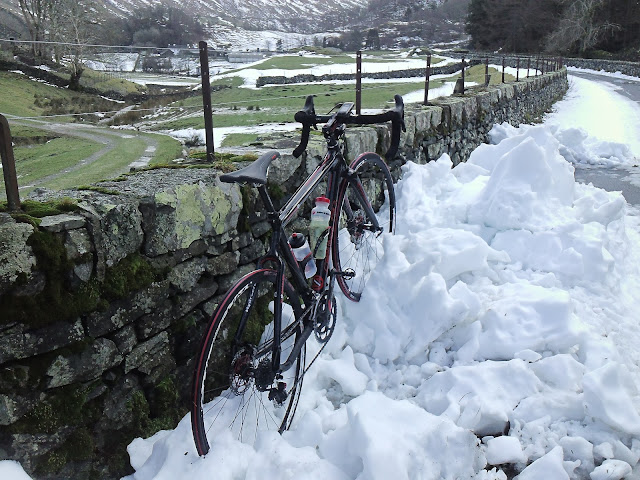A guide by an idiot building a bike
Part Four: Gears
Well finally, after a few weeks wait, I've pretty much got all I need to finish the bike.
 |
| A few more bits. |
The first thing I need to do, so I can get the saddle & bar heights right, is fit the chainset. I was going to get a full Campagnolo Centaur groupset but this Fulcrum carbon chainset is basically a cheaper re badged Centaur one that I think looks better. I think Campag' (and Fulcrum) are the only manufacturer that do a split crankshaft that bolts up in the middle. This leaves very clean crank arms with no bolts to collect the muck.
 |
| Fitted bearing shell. |
Another move away from the norm is the fact that the bottom bracket bearings are not fitted in the shells but fitted to the crank arms. The shells are simply screwed into the frame with a special tool (luckily its the same tool that fits the Shimano external bottom brackets, which I have). Then all you do is slide the arms in from either side, fit a little spring clip on the drive side to hold the bearing in place and fit the centre bolt. This also needs a special tool as its a long 10 Allen key. Nothing that a hacksaw, a 10mm Allen key and a 10 mm socket won't fix. Then out with the torque wrench to tighten everything up correctly.
 |
| Chainset fitted |
Modifications required from the start
Very early in the concept stage of this build I knew I would have a few issues to overcome. So none of the following were a surprise, just added to the challenge and the delivery times.
Cyclocross frames are designed for mud and to be carried over obstacles, so unlike normal road frames the gear cables are fitted on top of the top tube rather than under the main tube. This is all well and good until you try and fit gear designed for the road. My first problem was that all Campagnolo front derailleurs are designed to be pulled from the bottom (bottom pull). One solution is to fit a pulley below the front derailleur that changes the cable direction, these are not very aesthetically pleasing and a mud magnet. So along comes some simple but cleaver German engineering, an Umlenker from Speen.de. This little piece of stainless steel acts as a lever which changes the pivot point to allow a cable to pull from the top (top pull). It just bolts to the original cable clamp and allows the cable to be clamped at its end instead.
 |
| German Engineering at its simplest. The Umlenker |
 |
| Fitted to the front mech. |
 |
| All connected up. |
My next problem was a compatibility issue with the rear gears. No one (well at least no one I've found) makes a disc compatible wheelset that take a Campagnolo cassette. Shimano and Campagnolo spacings on the rear cassettte are not quite the same. Its down to about 0.16 mm per cog, on a 10 speed set up this is 1.6mm total and makes the difference between perfect shifting and jumping gears. The solution for this is made in America, the Shift Mate.
 |
| Shift Mate |
This simple device uses a double pulley that has two slightly different diameters, the cable enters the pulley on the larger side and goes right around the pulley, at the half way point it jumps to the smaller side and so changing the amount of cable pull. This allows for a Shimano compatible cassette to be used on a Campagnolo system.
 |
| Simple double pulley |
 |
| Rear mech fitted with shift mate |
Its not tested on the road yet but while setting up the gears it seemed to work a treat.
Well that's about it, bar tape is on, bottle cages fitted, gears set up (after adding some in line gear adjusters, I just couldn't get the new single action drop front mech set up without it!) and peddles fitted, I've finished building, a good test ride is needed to make sure all the heights are right, the gears are right, the brakes are bled properly and everything is tight. but that'll have to wait until the weather warms up. Yes I know is meant for the winter weather but its just to shiney to get dirty on its first ride out.
The Hydrocross. a.k.a. 'The dogs..........'
 |
| Not sure which is my best side, this one or.... |
 |
| This one. |
 |
| Nice clean crank arms |
















